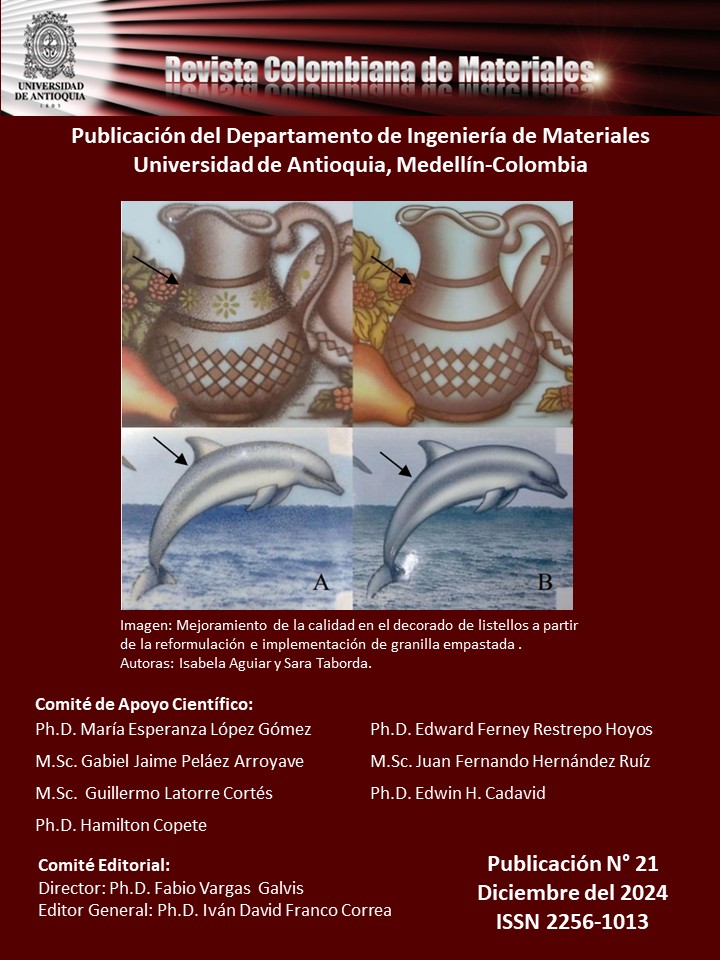Evaluación de las propiedades de mezclas binarias de poliolefinas mixtas y pla posconsumo con polipropileno reciclado
DOI:
https://doi.org/10.17533/udea.rcm.n21a01Palabras clave:
Reciclaje, mezclas de poliolefinas mixtas, compatibilidad, PLAResumen
Las poliolefinas constituyen una gran proporción del alto flujo de polímeros posconsumo. Debido a sus propiedades químicas y físicas similares se dificulta su recolección y clasificación diferenciada, por lo cual es común que se mezclen durante los procesos de reciclaje, razón por la cual se denominan poliolefinas mixtas recicladas.Por estarazón es importante obtener información acerca de su comportamiento térmico, reológico y mecánico y estudiar como varían estas propiedades en sus mezclas, lo que servirá para predecir su desempeño posterior y su estandarización técnica, facilitando el proceso de reciclaje. Es así como el objetivo de este trabajo es estudiar las propiedades de mezclas binarias depolipropileno reciclado conpoliolefinas mixtas recicladas, específicamente polietileno de alta densidad y polietileno de baja densidad recicladosen diferentes proporciones, sin usar agentes compatibilizantes. Además, se estudian mezclas de polipropileno recicladocon ácido poliláctico reciclado, como una alternativa para los desechos de la impresión 3D, un método de procesamiento muy común para este polímero. Las mezclas binarias se realizaron en proporciones de 20, 40, 60 y 80% en peso usando una extrusora de doble husillo y las propiedades de cada mezcla fueron determinadas por espectroscopía infrarroja, calorimetría diferencial de barrido, medidas del índice de fluidez y pruebas de tracción. Los resultados revelaron que, aunque si bien no había miscibilidad, las mezclas con polietileno exhibieron un aumento gradual de la resistencia a la tracción con la adición de polipropileno reciclado.
Descargas
Citas
ACOPLASTICOS, [Online], Available: https://acoplasticos.org/2024/09/12/plasticos-en-colombia-2024/, [Accessed: 25-Nov-2023].
Al-Juhani, A. A., Suleiman, M. A.,“Study of the Effect of EPDM Structure on the Compatibility of PP/LDPE Blends”, Arabian Journal for Science and Engineering, vol. 37, núm. 4, pp. 863–875, jun. 2012.
Al-Salem, S.M., Behbehani M.H., Al-Hazza’a, A., et al., “Study of the degradation profile for virgin linear low-density polyethylene (LLDPE) and polyolefin (PO) plastic waste blends”, Journal of Material Cycles and Waste Management, vol. 21, núm. 5, pp. 1106–1122, sep. 2019.
Aumnate, C., Rudolph, N., Sarmadi, M., “Recycling of polypropylene/polyethylene blends: Effect of chain structure on the crystallization behavior”, Polymers (Basel)., vol. 11, núm. 9, p. 1456, sep. 2019.
Cuiffo, M. A., Snyder, J., Elliott, A. M., Romero, N., Kannan,S., Halada,G.P., “Impact of the fused deposition (FDM) printing process on polylactic acid (PLA) chemistry and structure”, Applied Sciences, vol. 7, núm. 6, p. 579, jun. 2017.
Jones, H., McClements, J., Ray, D., Hindle, C. S., Kalloudis, M., Koutsos, V., “Thermomechanical properties of virgin and recycled polypropylene—high-density polyethylene blends”, Polymers (Basel), vol. 15, núm. 21, p. 4200, oct. 2023.
Karaagac, E, Jones, M.P., Koch, T., Archodoulaki, V.-M., “Polypropylene contamination in post-consumer polyolefin waste: characterisation, consequences and compatibilisation”, Polymers (Basel), vol. 13, núm. 16, p. 2618, ago. 2021.
Kukaleva, N., Simon, G. P., Kosior, E., “Binary and ternary blends of recycled high‐density polyethylene containing polypropylenes”, Polymer Engineering & Science, vol. 43, núm. 2, pp. 431–443, feb. 2003.
Nagarajan ,V., Mohanty, A. K., Misra, M., “Perspective on Polylactic Acid (PLA) based Sustainable Materials for Durable Applications: Focus on Toughness and Heat Resistance”, American Chemical Society Sustainable Chemistry and Engineering, vol. 4, núm. 6, pp. 2899–2916, jun. 2016.
OECD, “Projections of the environmental impacts of the plastics lifecycle to 2060,” In: Global Plastics Outlook: Policy Scenarios To 2060, OECD Publishing, 1st ed, ch. 6, Francia, 2022.
PLASTICS EUROPE, [Online], Available: https://plasticseurope.org/es/wpcontent/uploads/sites/4/2023/02/PLASTICOSSITUACION-2022-esp.pdf, [Accessed: 23-Nov-2023].
Posch, D. W., “Polyolefins”, In: Applied Plastics Engineering Handbook, M. Kutz, 2nd ed, ch. 2, Elsevier, USA, 2017.
Stuart, B., Infrared Spectroscopy: Fundamentals and Applications, John Wiley & Sons, New Jersey, 2004.
Sutar, H., Sahoo, P.C., Sahu, P.S., et al., “Mechanical, thermal and crystallization properties of polypropylene (PP) reinforced composites with high density polyethylene (HDPE) as matrix”, Materials Sciences and Applications, vol. 09, núm. 05, pp. 502–515, 2018.
Vervoort, S., Doelder, J., “Compatibilization of polypropylene–polyethylene blends”, Polymer Engineering and Science, vol. 58, núm. 4, pp. 460–465, abr. 2018.
Vollmer, I., Jenks, M.J.F.,Roelands, M.C.P., et al., “Beyond mechanical recycling: giving new life to plastic waste”, Angewandte Chemie International Edition , vol. 59, núm. 36, pp. 15402–15423, sep. 2020.
Descargas
Publicado
Cómo citar
Número
Sección
Licencia
Derechos de autor 2025 Revista Colombiana de Materiales

Esta obra está bajo una licencia internacional Creative Commons Atribución-NoComercial-CompartirIgual 4.0.








